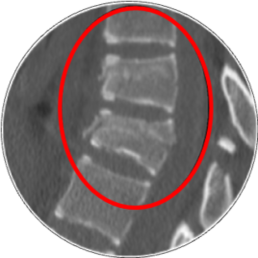Spinal Fractures Symptoms & Treatment Options
Spinal fractures are extremely serious conditions that can lead to a wide variety of symptoms, ranging from mild in intensity to debilitating. Sudden trauma, as well as underlying medical conditions, may be the cause.
Luckily, there are non surgical and surgical options to manage or treat spinal fractures.
The Human Spine
Your spinal column is a series of 33 bones that stretches from the base of your skull to your tailbone. These individual bones are also known as vertebrae. More specifically, the main bulk of the vertebra is called the vertebral body. When viewed from the side, this structure roughly resembles a log or square with a”waist like” middle narrowing .
At the back of each vertebra, other structures called pedicles and laminae form and arch that encases nerves and spinal cord, and serve as a protective shield. Bony protrusions known as processes, behind and to the side of the laminae form a cross like structure that allows for ligaments and muscles to attach and support the spine.
Functions of the spine include:
- Protecting the spinal cord, nerve roots, and internal organs
- Assisting with the motion of everyday activities such as bending, twisting, and standing upright
- Providing structural support to the body
What are Spinal Fractures?
Vertebrae are bones. Like just about any bone in the body, they can potentially break or crack. Spinal fractures occur when an outside force applies too much pressure or momentum to a bone. In many cases, the front of the spine (i.e. vertebral body) collapses while the posterior portion maintains its height. These wedge-shaped fractures, especially when occurring in multiple vertebrae, can lead to noticeable spinal deformities like a hunched back. Specifically, most spinal fractures occur in the thoracic and lumbar areas of the spine.
Medical conditions that may lead to spinal fractures include:
Osteoporosis: As we age, our bones lose density and begin to weaken. Vertebrae affected by osteoporosis can flatten and narrow, causing spinal deformities. Resultingly, applied pressure can cause weak vertebral bodies to crack and lose their height. Even everyday activities like twisting, reaching, or even sneezing can lead to spinal fractures. Read more…
Cancer: Those suffering from many forms of cancer can have the disease spread (or metastasize) to the spine. Breast, lung, and prostate cancers are common culprits. As tumors expand in size within the spine, vertebrae can suffer breaks.
Infection: While less common, infections in or near the spine may weaken the bones, causing fractures. Read more…
Previous spinal fracture: If you sustained a prior spinal fracture, you are more likely to suffer another one.
Medications: Certain drugs like oral steroids, antidepressants, or diabetes medications can weaken the bones. Unhealthy lifestyle habits and lack of exercise promote bone mass loss . Exercise helps your bones to stay strong. A sedentary lifestyle can decrease bone density. Also, smoking or heavy drinking may affect your body’s ability to absorb calcium affecting your bone quality.
What Causes Spinal Fractures?
For some, spinal fractures are the result of an injury or trauma. Falls, car accidents, sports injuries, and violent acts are some of the more common trauma-related causes. Essentially, these high-energy traumas push, torque or pull the spine parts past its breaking point. Excess flexion or extension can literally rip of soft tissue and bone fragments.
In many cases, additional injuries to the surrounding structures or other organs are present during trauma-related spinal fractures. It is important to request medical assistance right away if you suffer a trauma that affects your spine. Severe spinal fractures could include spinal cord injuries which, when left untreated, can lead to permanent damage.
But, you don’t need to experience a bad accident to suffer spinal fractures. Underlying medical conditions such as osteoporosis can make the vertebrae more likely to break.
Do You Think You Have a Spinal Fracture?
Have you been diagnosed with any of the conditions mentioned above that weaken your bones? Have you recently been in an accident or taken a bad fall? Do you experience pain with any motion?
If you suspect a spinal fracture, then you should consult with your doctor or an orthopedic specialist as soon as possible. Check out the next section to review the common symptoms of spinal fractures.
Diagnosing Spinal Fractures
If your spinal fractures are the result of trauma, you may need to go (or be transported) directly to an emergency room. Your injuries may necessitate immobilization with a backboard or a cervical collar during transport. From there, your ER team will collaborate to determine the extent of your injuries. Please call 911 immediately if you were injured in an accident. If you are released from the ER with bracing or medications we can assist with your follow up and care, prescribe refill or other medications medications, look at images to assure your fracture will heal correctly.
Less severe spinal fractures due to other conditions, such as osteoporosis, may require you to consult with a spine specialist. However, during a routine exam, your doctor will obtain a complete medical history and ask about the onset and severity of your symptoms.
Your doctor will then conduct a physical exam. This will include inspecting the head, chest, spine, limbs, pelvic bones. Your doctor may also administer neurological tests to assess how you move, feel, and sense position in your limbs, and to determine if any findings or limitations during your exam require further attention.
Once a spinal fracture has been accurately diagnosed, treatment can begin. The next section highlights common treatments for spinal fractures.
What Are My Treatment Options for Spinal Fractures?
Treatment for spinal fractures depends on the severity of your injury and the associated symptoms.
If the fracture is relatively stable (without excess motion or wobbly) then your doctor may recommend braces or orthotics. These conservative interventions maintain your spinal alignment while immobilizing your spine to aid in healing and provide support that relives pain while healing. Yes, in addition to the medicines that your doctor will prescribe you, braces can also help to control pain by restricting the movement of the injured area.
You may need to use braces or orthotics for up to 6-12 weeks. During that time, you will gradually increase activity with the assistance of a physical therapist. Taking pain medications during this time may assist with some of the uncomfortable symptoms from your fracture.
If after thorough review of your symptoms, physical exemption and diagnostic images or aids your doctor determines that your injury is not stable enough to support your spine and protect your nerves or neural elements, a surgery might be required to assist with proper healing and prevent or limit nerve damage and facilitate participation with therapy and care.
What are the Symptoms of Spinal Fractures?
Symptoms of spinal fractures can vary depending on the location and severity of the injury. In most cases, one will experience some degree of pain. This can be due to structural changes in the spine that affect other parts of the body. Pain may also be a sign of injuries to nerves, nerve roots, or the spinal cord itself.
If you were in an accident, you may have other injuries like head trauma or internal organ injury or lacerations. Other injuries—sometimes known as distracting injuries—cause pain that overwhelms your spinal fracture pain. Seeking immediate medical attention can allow you to pinpoint your exact injuries and determine if there were any fractures to the spine.
Other Symptoms Associated With Spinal Fractures Include:
- Neck or back pain occurring suddenly—especially after a fall an accident, assault or forceful motion
- Worsening pain while standing or walking
- Some pain relief while lying down
- Muscle spasms
- Numbness or tingling in other areas of the body including arms, hands, legs, and feet
- Height loss
- Limited mobility and range of motion
- Noticeable deformity of the spine (e.g. posture)
- Trouble controlling bowels or bladder
- Paralysis—a loss of movement in an extremity due to a spinal cord injury
More about Dr. Matin
The Spine Is Divided Into Five Main Regions, Including:
- Cervical spine: Seven vertebrae located in the neck region. The cervical spine is responsible for holding up the head.
- Thoracic spine: Twelve vertebrae located in the upper and mid-back. This section of the spine holds the rib cage in place, protecting the heart and lungs.
- Lumbar spine: Five vertebrae located in the lower back. These large vertebrae help to bear the weight of the upper body.
- Sacral Spine: Five fused vertebrae located near the hips.
- Coccyx region: Four fused bones that form the tailbone, a point of attachment for muscles and ligaments to the pelvic floor.
Your Doctor Will Likely Use A Variety Of Diagnostic Imaging Techniques To Visualize The Structures Of Your Spine. These Techniques Include:
- X-rays: Simple images of the bones created by using electromagnetic waves.
- CT or CAT scan: A computer axial tomography uses x-rays and a computer to produce vivid cross-sectional images of the body. These scans help your doctor determine if the bone is stable and if any nearby nerves are affected.
- MRI scan: The magnetic resonance imaging scan uses radio waves and a magnetic field to create detailed images of the soft tissues inside the body. These images show if the tissues involved include intervertebral discs (rubbery cushions between the vertebrae) and whether the fracture is new or old.
Spinal Fractures Symptoms & Treatment Options
Spinal fractures can be treated by Dr. Martin, give us a call to schedule an appointment.
We will provide different options of treatment.
Vertebroplasty
A minimally invasive procedure in which bone cement is inserted directly into the collapsed vertebral body. This can reduce or eliminate pain as well as stabilize the fracture.
Kyphoplasty
Similar to vertebroplasty, this minimally invasive procedure inserts a balloon into the affected vertebral body before applying the bone cement. This allows for height restoration in the bone before the cement sets in. If the fracture can be elevated with a ballon, the position of the bones will be corrected and heal in a more normal position to restore normal body shape and posture.
Spinal Fusion
In some cases, when the spina has excess and dangerous motion, spinal fusion surgery may be needed to fuse your bone fragments together with the assistance hardware such as plates, rods, screws and implants made of plastic or special metals that assist with restoring normal or near normal spine shape.
Decompression with fusion
In some instances after an injury of suffering a fracture, bone fragments may compress your spinal cord and or nerves. Removing this pressure is essential to assist with recovery. In addition to removing bone fragments or bones your surgeon uses fusion techniques to assist with healing and facilitate participating in therapy and recovery.






